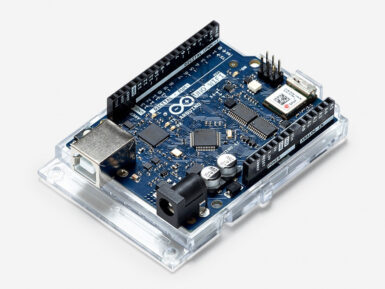
Overview
The DFRobot Expansion shield introduced to the market the famous color code for sensors and actuators input and output. The 3 pin format for Signal, Voltage and Ground is extremely useful, specially if used altogether with our increasingly large range of modules, sensors and devices that just fit. Alternatively, the board includes power input for salvaged power supplies or laboratory power supplies. Very common Xbee socket for multipurpose wireless connectivity such as RF, wireless, bluetooth.
The new version includes a voltage hardware setting through a jumper to allow compatibility with a bigger range of components at 3.3v. It also includes a Servo external power, with a protective diode. This way you can enable a large range of servos from your Arduino.
Latest version features a convenient switch that lets you program your ATmega328 boards like UNO, while you have another Serial device connected like a Xbee. Switch it, program it and get it back up and running with another switch. You don't need to disassemble your hardware or wiring. A LED on top board and a reset button is in order to make it just a natural extension to Arduino boards. The LED is connected to pin 13.
Features:
- Compatible with the Arduino Due
- 3.3V/5V operating voltage select
- Switch for wireless communication & programme
- More Easily recognitive interfaces
- Colorful header for illustrating digital or analog pins
- Immersion gold surface
Tech specs
- Input Voltage
- 7-12V, PWR_IN
- 4.8-6V, SERVO_PWR, depending on your servo
- Compatible module voltage: 5V/3.3V
- Support interface: I2C, SPI, Xbee (Xbee pro), Bluetooth, APC220
Get Inspired

Sending data from an Arduino microcontroller to the ThingSpeak platform using a GPRS module, specifically the SIM800.

Dream team for classrooms worldwide: Arduino Uno WiFi Rev2 for CTC GO! joins Open Roberta Lab, the biggest open source coding platform made in Europe. The Arduino Uno WiFi Rev2 is the fourth Arduino board to be integrated into the Open Roberta Lab, which is currently supporting a total of 13 robots and microcontrollers to enable children worldwide to adopt a playful approach to coding. By “dragging and dropping” the colorful programming blocks called “NEPO” hundreds of thousands of users worldwide from more than 100 countries per year create their own programs to make their hardware come to life. “Fraunhofer offers guaranteed quality, both on the technical level as well as for community support," says Arduino CTO David Cuartielles. "There are a lot of synergies in our cooperation. Roberta is really meant for teachers to learn how to teach technology which is a key part of the Arduino Education’s mission." The CTC GO! - Core Module containing eight Arduino Uno WiFi Rev2 is supporting the joint mission of Open Roberta and Arduino in providing teachers with a getting started program including eight lessons, eight guided projects, and six self-guided projects that teach students how to use electronics and introduces them to programming and coding. The lessons increase in difficulty from the very basics all the way through to learning different programming capabilities and building circuits for different sensors and actuators. During the self-guided projects, students practice building structures and applying the knowledge acquired in the hands-on lessons to develop their critical thinking, creativity and problem solving skills in a collaborative manner." Arduino first joined Open Roberta in 2018, when the microcontrollers Arduino Uno, Nano, and Mega were integrated into the Open Roberta Lab. The lab is the technological component of the Roberta initiative, which was started by Fraunhofer IAIS in 2002. 18 years of experience in STEM






